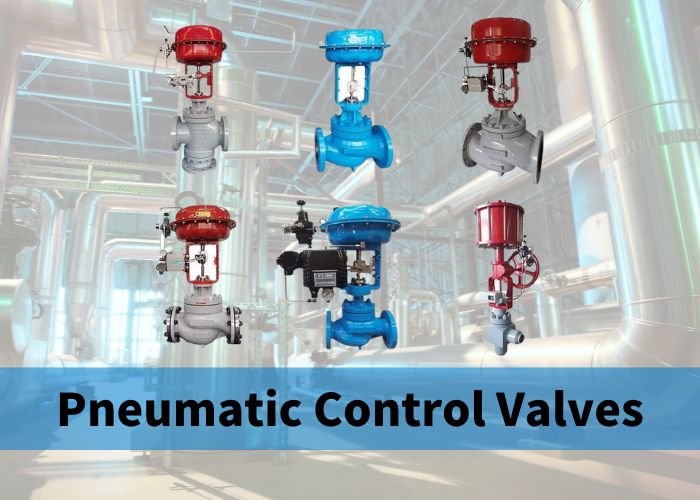
I: Introduction
Pneumatic control valves are revolutionizing how industrial fluid control processes are handled and optimized. These valves are advanced mechanisms that utilize compressed air as a means to control the flow of various fluids, including liquids, gases, and slurries. They find extensive applications across multiple industries, such as oil and gas, chemical manufacturing, pharmaceuticals, and water treatment.
Industrial fluid control is critical to the smooth operation and efficiency of industrial processes. It entails controlling the flow, pressure, and direction of fluids within a system, which directly impacts the operation’s quality, safety, and productivity. Pneumatic control valves have emerged as a game changer in this industry, providing improved precision, flexibility, and dependability.
Industries can enhance fluid management, reduce operational costs, increase safety, and achieve higher levels of efficiency by using the power of pneumatic control valves. These valves have transformed how fluid flow is regulated, enabling tighter control, adaptability to various applications, and seamless connection with digital systems. In this article, we’ll look deeper into pneumatic control valves and how they change industrial fluid control.
II: The Basics of Pneumatic Control Valves
A. Pneumatic control valve working principle:
The working principle of a pneumatic control valve involves using compressed air to control the flow of fluids.
§ Actuator Control: The pneumatic control valve’s actuator gets a control signal from various sources, including sensors, controllers, and computer systems. The required flow rate, pressure, or other parameters are indicated via the control signal.
§ Actuator Response: The actuator responds to the control signal by transforming the compressed air energy into mechanical motion. A pneumatic control valve’s actuator can be either diaphragm-operated or piston-operated.
§ Valve Plug Movement: The mechanical motion of the actuator is communicated to the valve plug, which is the movable part that controls fluid flow. The valve plug can be a disc, ball, or cylindrical plug depending on the design.
§ Flow Regulation: By moving the valve stopper, the actuator alters the flow of fluid. By altering the valve plug’s position, precise control over the fluid’s flow rate, pressure, and direction can be achieved. When fully extended, the valve stopper enables maximum flow and when closed, it blocks flow.
§ Feedback Control: Sometimes, a positioner may be utilized with the actuator to enable the exact valve plug location. The positioner receives feedback from sensors or other devices to ensure accurate and consistent valve positioning.
§ Control Signal Adjustment: The control signal can be altered if the flow rate or other parameters need to be changed. The actuator responds to the updated control signal by readjusting the position of the valve plug, resulting in a change in fluid flow.
B. Components of Pneumatic Control Valve:
§ Valve Body: The valve body provides the main structure of the valve and houses the internal components. It is built to withstand the pressure and temperature of the fluid under control.
§ Valve Plug: The valve plug is the movable element that regulates fluid flow. It can have various designs, such as a disc, ball, or cylindrical plug. The shape and structure of the valve plug depend on the specific application and fluid characteristics.
§ Actuator: The actuator moves the valve plug to control the fluid flow. It converts the control signal into mechanical motion. Pneumatic control valves typically use pneumatic actuators powered by compressed air. Depending on the design and application requirements, the actuator can be a diaphragm or piston.
§ Positioner: The positioner is an optional component that works with the actuator to position the valve plug precisely. It receives the control signal and provides feedback to the actuator, ensuring accurate and consistent valve positioning.
§ Accessories: Pneumatic control valves may include additional accessories to enhance their functionality and performance. These include pressure regulators, solenoid valves, limit switches, and position feedback devices.

C. Advantages of using Pneumatic Control Valves over other valve types:
§ High precision and accuracy in fluid control
§ Quick and responsive operation
§ Wide range of fluid compatibility
§ Ability to handle high pressures and temperatures
§ Robust and reliable performance
§ Cost-effective and low maintenance
§ Fail-safe operation
§ Easy integration with digital control systems
§ Modular design for easy installation and replacement
§ Energy-efficient operation.
III: Enhanced Precision and Accuracy
A. Improved control over fluid flow
B. Ability to fine-tune valve settings
C. Minimizing errors and optimizing process efficiency
IV: Flexibility and Adaptability
A. Wide range of applications for pneumatic control valves
B. compatibility with various fluid types and pressures
C. Modular design for easy integration into existing systems
V: Cost-Effectiveness and Energy Efficiency
A. Reduced maintenance and operational costs
B. Energy-saving features of pneumatic control valves
C. Return on investment in the long run
VI: Safety and Reliability
A. Fail-safe mechanisms in pneumatic control valves
B. Protection against leaks and system failures
C. Conformity to industry standards and regulations
VII: Conclusion
Pneumatic control valves revolutionize industrial fluid control by providing great precision, adaptability, and reliability. Their capacity to precisely regulate fluid flow, fine-tune valve settings, and maximize process efficiency makes them vital in sectors that require precision fluid management. Industries can boost efficiency, cut expenses, and increase safety by utilizing these valves.
Industries must investigate and implement pneumatic control valves in their fluid control systems. Integrating them with digital control systems and maintaining up to date on valve technology improvements will enable even more imaginative solutions. Using pneumatic control valves allows sectors to rethink their approach to fluid control, pushing the limits of what is possible while reaping the benefits of precision, adaptability, and efficiency. C







